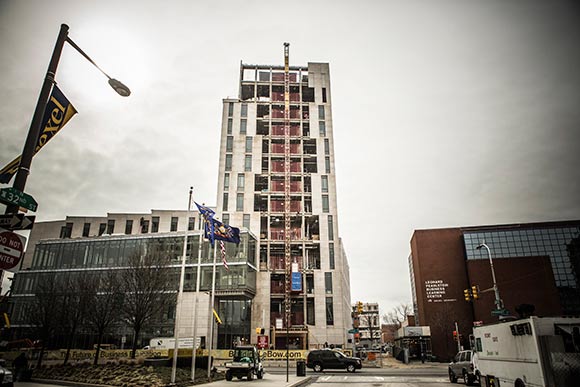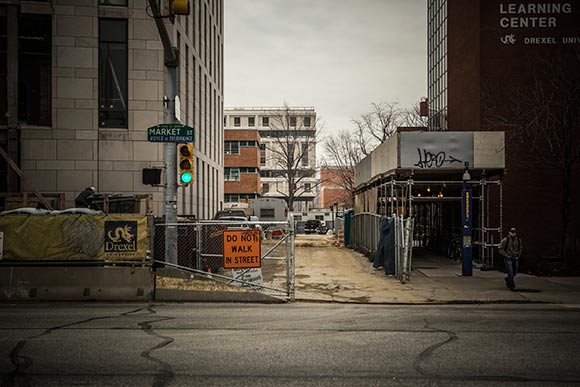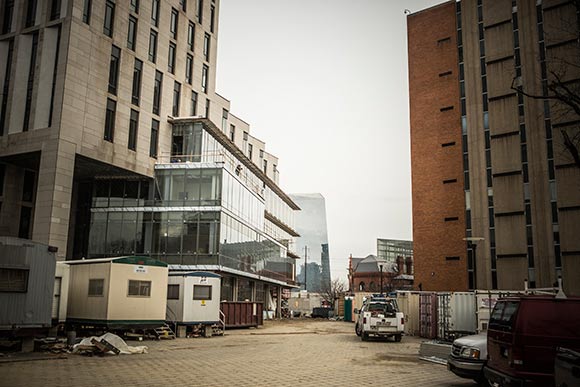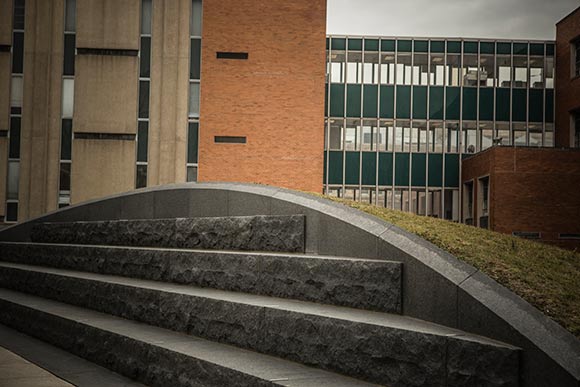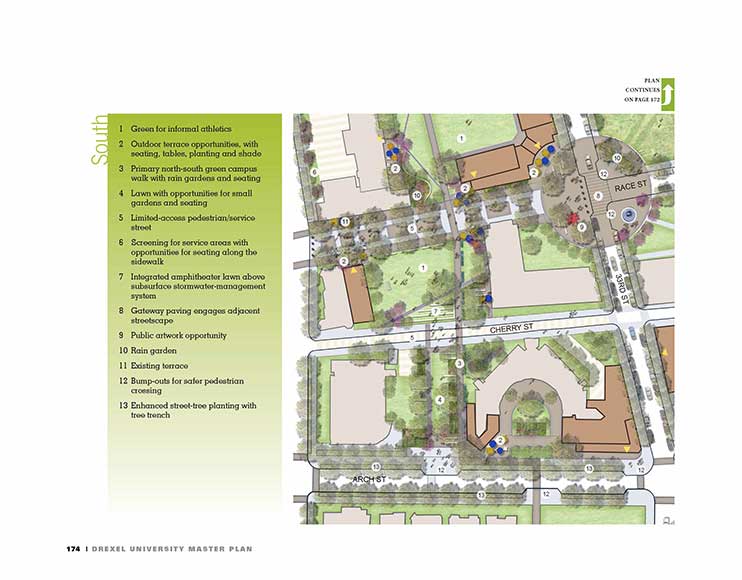For much of the 20th Century, the terms “urban” and “campus” weren't natural bedfellows. But in the 1990s, a paradigm shift occurred and a new school of thinking emerged on how to best create a modern urban campus in Philadelphia.
Leading the charge was then-University of Pennsylvania Vice President John Fry. He implemented innovative efforts to integrate Penn's physical presence into the fabric of surrounding neighborhoods. Then, after a stint as president of Franklin & Marshall College, Fry was lured to Drexel.
Clearly, the area where this new urban ethos will have the most radical local impact is West Philly's University City. Penn has a headstart and now Drexel — with President Fry at the helm — is launching a massive, progressive development strategy that has the potential to invigorate the area while also protecting the character of adjacent neighborhoods.
Under an Updated Master Plan, the university plans to spend roughly half a billion dollars on construction in the coming years, primarily geared towards embedding a mixture of uses into every campus building and centralizing the school's core — building up instead of out into surrounding neighborhoods. Gleaming residential towers and new state-of-the-art educational buildings have defined Drexel's recent urban makeover.
Now, thanks to a recent $5 million gift from the Raymond and Ruth Perelman Education Foundation, the campus is shifting its urbanization efforts towards the spaces between the buildings, starting with a dynamic new public plaza.
Space Race
In the coming years, Drexel will completely reimagine the center of its campus along the 32nd Street Esplanade between Chestnut and Market Streets. The new public space, dubbed the Raymond G. Perelman Plaza, is envisioned as the central gathering and events spot for the new urban Drexel.
“It's the first project to come out of the [Updated Master Plan] that aims to fill the voids between buildings,” explains Robert Francis, Vice President of University Facilities. “We've had a number of building projects that really urbanize our campus. With [Perelman Plaza] we can begin to shape the outdoor space as well.”
The new plaza is situated between two of the university's largest building projects: the new LeBow College of Business on one end and Chestnut Square on the other, a new residential and commercial center that's already attracted top-notch culinary talent — it will house Zama's second location coZara, Philly's second Shake Shack, local pizza haven Zavino and New York-based Joe Coffee.
These uses will no doubt bring added vitality to the new plaza, a part of campus that already sees its fair share of foot traffic. Currently, a pedestrian mall occupies what will become Perelman Plaza.
Strangely enough, the space was actually redesigned 10 years ago — but times have changed. Quickly. The mall is already outdated.
“The current design is stuck in the past,” says Francis. “It reflects a time when pedestrian counts were much lower and our [urbanization] goals for campus were much different.”
With pop-up parklets, sustainable strategies and programmed activities becoming the norm in shared spaces, expectations for how an urban plaza functions have changed. Perelman Plaza will include a number of stormwater mitigation design strategies, ecological landscapes, as well as a large outdoor seating area for events or concerts.
“The new plaza will be able to hold up to 1,000 people for events,” says Francis. “Drexel currently doesn't have an outdoor venue of that capacity.”
Some aspects of traditional urban plazas will still be encouraged; according to Francis, over time, surrounding ground-level retail spaces will be renovated to open up onto the plaza itself. The new plaza will be managed by Drexel, but will be available for outside use and programming.
Local firm Andropogan Associates has been tapped to design the plaza, a process Francis expects to be complete in the spring, with construction beginning in the summer and wrapping up by the end of 2013.
Good Neighbors
Local civic groups have been a big proponent of the Updated Master Plan. Its emphasis on concentrating students in more densely packed residential towers along Market and Chestnut Streets has members of nearby neighborhoods hopeful.
For years, Powelton Village has felt the brunt of campus development creeping into its neighborhood. Now, according to George Poulin with the Powelton Village Civic Association (PVCA), some feel the area has become overwhelmed with student housing; many Powelton Village homeowners want Drexel students to move away from their neighborhood and live on campus.
“Frankly, with a 12 percent owner-occupancy rate, Powelton Village simply cannot absorb any additional student renters,” explains Poulin.
With the Master Plan's urban tilt — a principle shaped by Drexel in conjunction with the PVCA and other neighborhood groups — Poulin is optimistic about Drexel and Powelton Village becoming better neighbors once again.
“It is heartening that the university is finally setting their eyes on expansion eastward instead of toward the neighborhood,” says Poulin. “As long as Drexel develops in a way that minimizes any potential impact on Powelton Village, the neighborhood will be supportive of their efforts.”
But Poulin is also quick to note that worries surrounding neighborhood development creep still persist. For instance, Drexel has recently proposed a 24-story student housing tower at 34th Street and Lancaster Avenue, right on the edge of Powelton Village.
“While the PVCA and Drexel master plans both support high-density mixed-use developments at that location, many neighbors have been taken aback by the sheer scale of the development being proposed,” explains Poulin. “Few neighbors expected the tallest building on Drexel's campus to be put at the foot of our neighborhood's commercial corridor.”
Drexel and developer American Campus Communities recently gave a presentation on the project and fielded community questions. It remains to be seen if PVCA will endorse the effort or if a battle will ensue.
The development is seen as a key site to bridge the community and the campus, and it isn't the only project on the docket — two more important public space improvements are in the works.
Looking Forward
Whereas Perelman Plaza is harnessing energy at the campus core, the two future goals – improving the Main Quadrangle a block west of Perelman Plaza (adjacent to Penn) and creating a North Campus Mall along 33rd Street from Market Street to Powelton Avenue – aim to improve neighborhood connectivity at the edges.
Taken together, the two projects will create central green spaces, tie existing open spaces together, beautify the urban environment and create gateways to Drexel's campus.
As these efforts move forward, they're likely to see less resistance than the 34th and Lancaster Avenue development. For an urban campus, bringing activity to the street and activating outdoor spaces is something most parties can rally around.
With Perelman Plaza and other public realm efforts planned for the coming years, that's the direction Drexel is clearly moving towards.
“[Perelman Plaza] is a really big step forward for us,” says Francis. “We've modernized buildings. Now we're turning our streets into outdoor classrooms.”
The University City Science Center has partnered with Flying Kite to showcase innovation in Greater Philadelphia through the “Inventing the Future” series.
GREG MECKSTROTH is Flying Kite's development news editor.
